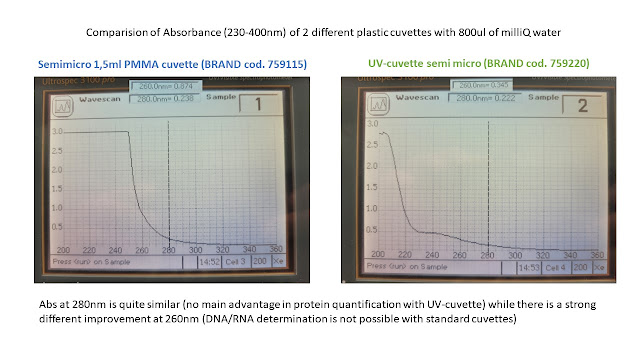As already reported in the ProteoCool Pills#13, and ProteoCool Pills #24 several different methods are currently available to perform quantification of purified DNA fragments and plasmid as well as recombinant proteins and antibodies.
One simple method common to both, DNA and
protein quantification is the spectrophotometric determination in the UV range
(260nm for DNA and RNA and 280nm for proteins and monoclonal antibodies)
Spectrophotometric quantification has several advantages:
- Cheap (do not require any specific reagent);
- Fast (do not require sample pre-incubations);
- Non-destructive (the sample could be recovered);
The main drawback that limits in the past the
use of the UV quantification was the fact that standard glass and standard
plastic absorbs strongly in UV region and the quartz cuvettes were necessary to
perform protein (280nm) and DNA (260nm) quantification.
Quarts cuvettes work well in both UV and
visible regions (right from 190 nm) but are expensive, fragile and time
consuming, because not disposable and therefore it need to be carefully washed
between the different samples.
Of course the same limitation is applicable
also to the multiplate reader, because the standard plastic bottom plates
cannot be used for measurements in <300-320 nm due to the plastic
absorbance.
Solutions:
1) Use a microvolume UV-Vis spectrophotometers (eg Nanodrop) that do not require any specific support (plate or cuvette):
Pros:
Low sample volume (2 µl)
Fast
Simple
Cons:
Less sensitive than cuvettes because the optical path is 1mm instead 10mM of the cuvettes
Lambert-beer law à Abs=ebc where b is the optical path
For the same sample e= constant à 1/10 of optical path à 1/10 of Abs at the same c (concentration)
Need to be carefully cleaned (protein buffers are rich of salt and the surface properties of the pedestals can be compromised and the samples drop Flattens out and the read are not reproducible
2) Use Plastic UV-Cuvette or UVclear multiplates:
In the recent years special plastic compounds with low absorbance at wavelength >220nm were developed:
In this post I would like just to provide some example of comparision of background Abs260 and Abs280 signal obtained with standard and UV-transparent plastic matherial:







Educative post;)
ReplyDeleteThank you for tests. Usefull information.
ReplyDelete